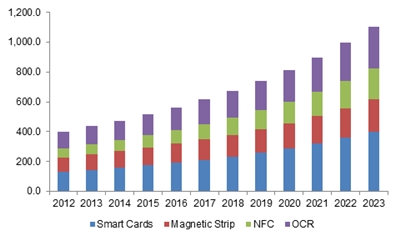Software based Automated Fare Collection Systems market to observe massive growth over the period 2016-2023, Smart Cards large scale adoption to push the demand
Publisher : Fractovia | Published Date : 2017-04-06Request Sample
Automated Fare Collection (AFC) Systems market has already gained a huge popularity owing to the growing consumer demand for transparent, hassle free, and efficient fee collection methods. Today, AFC technology is extensively implemented across a wide end sectors including public bus services, railways, cab services, and airport for paperless fare collection. Enhanced revenue management, fraud prevention, along with considerable developments in public transport infrastructure are some of the key factors behind this automated systems’ large scale deployment. As per the report by Global Market Insights, Inc., “Worldwide automated fare collection systems market was worth around USD 4.5 billion in 2015 and is poised to grow at a CAGR of 10.4% over the period of 2016 to 2023.” Shifting trends toward cashless transaction mainly via mobile and contactless smart cards is expected to have a strong impact on the overall market dynamics.
Based on technologies, automated fare collection systems market is segmented into smart cards, near field communication (NFC), optical character recognition (OCR), and magnetic strip. OCR-based automated fare collection systems industry is projected to generate substantial revenue over the coming six years driven by the growing installation of this technology based automated systems across the tickets and bills receipts counters. Smart cards covered more than 30% of the global market share in 2015 and is expected to grow significantly over the coming timeframe. Smart card offers benefits such as authentication, identification, application processing, and data storage along with it is handy and cost effective.
UK automated fare collection system market size, by technology, 2012 - 2023 (USD Million)

NFC technology based market will also grow substantially with a CAGR estimation of 12.3% over the period of 2016 to 2023. Attributing factors of this transaction systems such as higher compatibility, user friendliness and swiftness are influencing its large-scale adoption. In addition, it can readily be incorporated with mobiles and smartphones, which in turn, will stimulate automated fare collection systems industry share.
Hardware and software are the two main components of automated fare collection systems market. Software component segment is predicted to grow at a rate of 10.4% over the coming years of 2016 to 2023, owing to the escalating development of software based AFC platforms. With the increasing proliferation of consumer electronics automated fare collection systems industry is observing a noticeable change in terms of market outlook. Hardware component segment collected a revenue of more than USD 2.2 billion in 2015 and will observe considerable growth rate over the coming six years.
U.S. automated fare collection systems market to witness maximum growth in the coming years, at a striking CAGR of 9% over the period of 2016 to 2023.
North America AFC systems market, driven by U.S. accounted for 85% of the reginal revenue in 2015, and is poised to continue its regional dominance in the global landscape. Being an integral part of Intelligent transportation systems (ITS) market, the automated fare collection systems industry will spectate significant growth in coming years based on the global transport infrastructural development.
Asia Pacific automated fare collection systems market is slated to exceed a revenue of USD 2.5 billion by 2023. The growth can be attributed to the increasing investment in the transportation activities across APAC. China and India will be the major revenue contributors.
On-going research for upgradation of the old AFC systemss to maintain the business position, strategic partnerships, new product development, joint ventures, and reduced capital cost are some of the major strategies adopted by the market players to sustain in the competitive market. Prominent industry participants in automated fare collection systems market include Samsung, Cubic Systems, Atos, Thales Group, and NXP Semiconductors.